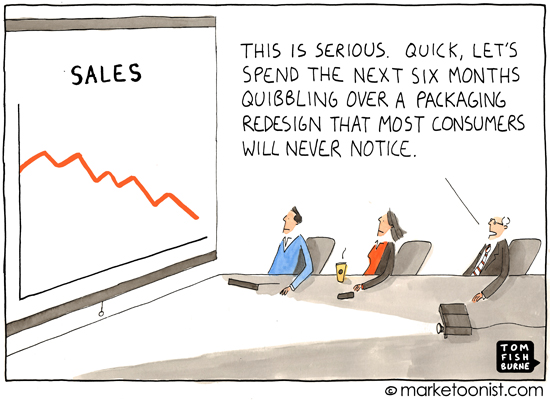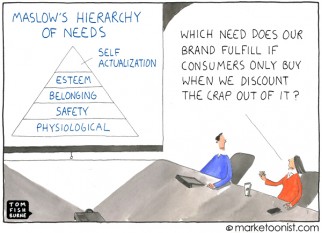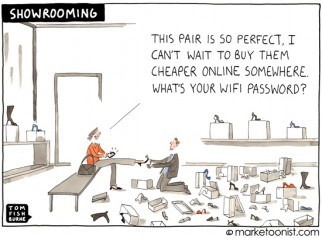A packaging redesign is often the first lever that marketers pull when they are either new to a brand or facing a marketing challenge. If all else fails, redesign the packaging and slap a “New Look. Same Great Taste” burst on it.
From my time at method, I learned that packaging design, when done well, can be the best media vehicle a brand has. We thought of cutting steel (for a packaging mold) as a media expense.
But a packaging redesign is not a magic bullet. And the process is often heavy on politics and light on impact. It is easy to get caught up in endless discussions about nuances that ultimately aren’t all that important to consumers.
There is also a fear of more ambitious redesigns, partly due to the “Tropicana hangover”. in 2009, Tropicana changed its label to a design that was universally disliked. They eventually backpedaled to the original design. I’ve talked to many marketers who are wary of any bold design changes because they don’t want to make the same mistake.
I like this insight from Landor: “Many companies evaluate packaging only when their brand is languishing or when a new variant is about to launch. Don’t think of refreshing your packaging as a project with an end date; instead, the “evolution of packaging” should be a regular conversation and a strategic choice as your brand strategy evolves.”
I like the idea of packaging as an ongoing evolution rather than a short-term fix.
(Marketoonist Monday: I’m giving away one signed print of this week’s cartoon. Just share an insightful comment to this week’s post by 5:00 PST on Monday. I’ll pick one comment. Thanks!)



Tessa Stuart says
Packaging changes can never fix the problem if there is an inferior product inside. Consumers are more savvy now. If the rate of sale is slow, it’s either:
– new, unknown product starting out, waiting to be trialled and trusted and bought repeatedly, in which case sampling will help
– it’s over-priced for what it is
– people have tried it once and won’t do so again, in which case it’s the product that is the issue.
Evolution of the pack design is useful, because sudden changes throw off the consumer used to shopping by colour or symbol for their familiar grocery. Who hasn’t sometimes hunted for a particular store product, asked a store assistant, and then found it, re-branded, looking entirely different?
Bill Carlson says
Likely we all agree that packaging redesign won’t directly save a product or product line that is wrong for consumers (e.g. wrong features, benefits, needs, interests, quality). But I have personally seen packaging redesigns make a positive impact on sales, and smart marketers playing the long game aren’t letting social media and mobile marketing hype get in the way of regularly revisiting their actual, real-world, on-the-shelf presence to maximize results at the “moment of decision.” (And they also realize that those newer and sexier tactics, which feel “quicker and less expensive to implement”, are no more a “silver bullet” solution than a packaging change! Bet you had a similar cartoon about that as well!)
The Tropicana story suggests appropriate caution about making a packaging change. The process needs to be smart — and that’s where you run into 10 or more of your cartoons from the past — debating creative briefs, value of consumer research, managing (controlling!) the creative process, more about consumer research, establishing a clear message without overwhelming the shopper, getting the client to trust their agency and their agency to trust objective information, managing egos in the decision-making process, etc. I would love to have been a “fly on the wall” to see how that particular (Tropicana) story evolved…
Interestingly, while a packaging redesign itself may not be one-tactic solution to lackluster sales, if it’s done properly it may actually uncover the underlying issues. Doing it right forces a rewind all the way back to defining targeted consumers and understanding what they are looking for, exploring (fresh!) how a brand’s offering competes with others (brand visual i.d. as well as products), what the retail environment looks like (now!), development/confirmation of positioning/competitive differentiation, and more.
Your comments about your time at method are spot-on — in fact, we try to apply (educate, sell!) the same argument about packaging being a marketing investment rather than a cost of goods – and to push the point, arguing increased ROI relative to media given that the interaction actually happens with the product in the shopper’s hand!
Concetta says
I think what Bill said makes a lot of sense – that marketers should exercise “appropriate caution” about making a packaging change.
In terms of marketers fearful of making bold design changes, they need to learn more about exactly WHY the Tropicana redo failed. It failed because the consumer couldn’t see the product amongst a sea of other choices, and it lost its reason for standing out in the market. If the consumer can’t find your product, they aren’t going to buy it! Further, there were mistakes made in the process that are too long to write about on a blog – I wrote a 20 page paper about it for my MBA level marketing class.
But the marketers need to understand – Tropicana moved on from there, creating new packaging for Trop50 and their other products, including a brand new package this year: http://www.heraldtribune.com/article/20120725/ARTICLE/307259993 Even Peter Arnell, the designer for the Tropicana packages that were removed, has moved on and created some pretty amazing packaging. His packaging for Sobe Lifewater is awesome, the Pepsi redesign got a lot of negative buzz at first but consumers like it and sales are doing better from it.
My point? Marketers limping along using the Tropicana rebranding as a reason not to repackage are lazy and relying on the status quo. A brand needs to freshen up every now and again or they risk losing their story in what are some very oversaturated markets.
Nalini Baruch says
A superbly timed newsletter Tom as we have just hired a creative company to look into ackaging redesign on our behalf. We will heed all the advise given including those included in the posted comments. This is a nervous yet exciting step for us as the brand is now 12 years old and pretty much unchanged in that time. In that 12 years our brand has existed, more and more brands have joined us on the shelves and the aim is firstly to match our packaging to the quality of our product and to stand out as well.
Jen Nelson says
First of all I have to say, I wasn’t sure whether to laugh or cry at this cartoon because I have lived it. (Often humor/cartoons work with exagerrations or hyperbole… sadly, this one is something I have literally experienced).
Second, I feel compelled to amplify the closing suggestion of an on-going evolution. Even if breakthrough design isn’t your brand’s “thing” (like Method), untouched for years, a package will looked aged, out of date, wall papaer. And as it turns out evolving it over time is warranted from both a top and bottom line perspective: Most (studies vary but +65%) of CPG packaging changes that aren’t functional (- those that don’t actually improve the usage experience) have negative effects on demand sales (when you interrupt their mindless buying habit as often happens with anything other than evolutionary package changes, you open yourself up to competition stealing the transaction). So you have to spend to offset the declines (either through just simply more A&P and/or the costs to label/sticker said “same taste, new look” explanations.
Anyway you slice it – sage advice, Tom.
Jeff says
I recently bought really cool European style glasses. I look so much smarter my own family didn’t recognize me… then I spoke and poof the image is gone… I’m just regular old anglo-american guy. Why? It’s a “package” change not a substance change. Not to jump on the pile, but it’s true it won’t be the fix that rockets sales to previous levels. If anything it’s to defend the turf you have if you haven’t significantly changed anything in the product and it performs the same. (even with the new pastel colored box) Even store brands do this if you look at the largest big box store that is also the largest in gun sales (who knew?) in the recent past changed their look (package) but have the same cheap stuff inside. I’d love to see if it paid off. I think JCP would also like a redo truth be told….European corporate glasses…
Allen Roberts says
Packaging as an evolution is a marketing must. I suffered my own “Tropicana hangover” years ago when I completely redesigned an old, crappy, unclear pack that suffered from every disease available, to a new, attractive, descriptive pack, and sales stopped. I had failed to recognise people did not buy the brand, they bought the product inside, and when the pack changed, they could not find it any more.
Vegemite, that iconic Australian spread (marketed by Kraft, but repulsive to Americans), is a great example. I recently saw a retrospective of their packaging back to the 30’s, and the changes have been very substantial over time, but incremental so that consumers have not noticed each one as it happened. The product is now close to 100 years old, and in an unassailable position in Australians pantrys, and probably delivers Kraft huge margins, as it is, after all, based on a waste product that before Vegemite, had been dumped.
Alex Hagan says
Vegemite, that iconic Aussie brand that Allen refers to, had their own Tropicana moment a few years ago when they crowd-sourced a name for a new product and decided on “iSnack 2.0”. It was widely seen as a pandering and cynical brand and consumers weren’t only disappointed, they were outraged – so they changed the name of the product after a few short weeks. I kept a jar of “iSnack 2.0” as a reminder of the importance of authenticity in marketing.
DSprogis says
First impression: I thought this might be factions in Congress considering how they might repackage themselves.
Mike Paul says
I’m impressed with the range and depth of insight to this comment string. My two cents based on 16+ years at General Mills.
Comment from a wise colleague in field sales “You know they’ve got a new manager on a business when the brand design changes”
Despite the advent of digital media and targeting niche of traditional media – I truly believe that for most CPG brands, the package is THE most important marketing element of a brand. Three lessons learned from observation or experience: (1) Less is More! The package needs to grab you from 10 feet…the more flags, claims, and visuals, the more it becomes recessive (use the other sides of the package to reinforce claims, etc) (2) Color Rules: While its obvious, I’m always surprised how many marketers violate the importance of color in setting tone and expectations (I recall a redesign of a blueberry muffin package from blue to yellow…with no other changes to the brand’s support – sales tanked. The brand team went back to blue and sales improved, (3) Package Change = Product Change: Consumers WILL perceive that you’ve changed the product with a wholescale brand redesign (even if you add the flag “New Look Same Great Taste”). Thus, hold off on large scale redesign unless you’ve actually changed the product.
tomfishburne says
Wow, I really learned a lot from you this week, many thanks! It sounds like many of us have been in the same trenches. This week’s print goes to Concetta for unpacking even more of the lessons from the Tropicana case study. Thanks, everyone!
-Tom